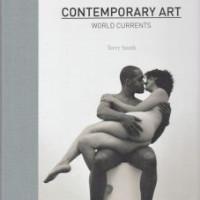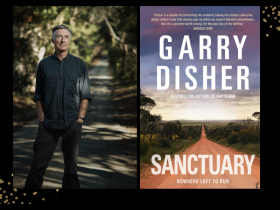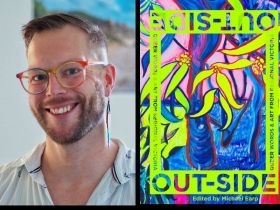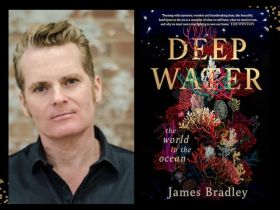The book opens with a consideration of the transition from late modern art to now, showing the outgrowth of contemporary art from late modernism and the international explosion of the contemporary art boom. Smith takes a decidedly global approach, surveying most of the world before probing a little deeper into key themes – World Pictures: Making Art Politically; Climate Change: Art and Ecology; Social Media: Affects of Time (where his view on time and temporality appear articulately) and a Coda: Permanent Transition.
The book is very well and very thoughtfully illustrated and a number of Australian artists make the cut, not just in the section on Australia (where Smith gives and excellent account of contemporary indigenous art) but also in the mainstream section. Notably Patricia Piccinini, Hany Armanious and performance and political artist Mike Parr appear. The numerous illustrations are excellent; the author and publisher have chosen a relatively large image size to illustrate the text, and it works well. There is a comprehensive index and bibliography as well as a list of suggested resources.
Smith comes with a near impeccable art historical pedigree, having studied in Australia under Bernard Smith, and in the USA under Meyer Shapiro, both preeminent scholars of their time. Since the early 1970s he has been associated with the Art and Language group of conceptual artists, which include Joseph Kosuth and Ian Burns. He came to wider prominence when his 1986 doctoral thesis was published as Making the Modern: Industry, Art and Design in America (University of Chicago Press, 1993), later receiving the inaugural Georgia O’Keeffe Museum Prize for the best book on modern American art published in the past 25 years. His work on Australian art, especially his two-volume Transformations in Australian Art (Craftsman House, Sydney, 2002), remains highly regarded and influential.
For around a decade now Smith has held the Andrew W. Mellon chair of Contemporary Art History and Theory at the University of Pittsburgh. He made the first part of his reputation as critic, theorist and historian here when he served as Power Professor of Contemporary Art and Director of the Power Institute at the University of Sydney. He still maintains an academic professorial appointment at the National Institute for Experimental Arts in the College of Fine Arts and the University of New South Wales. He is highly regarded for the quality and originality of his thinking and, notwithstanding his US base, remains an important advocate of Australian art – in 2010 he received the Australia Council Visual Arts Award in part for “advancing the reputation of the Australian artistic sector”.
In the acknowledgement section, Smith recounts an anecdote where the late TJ Clark praised Bernard Smith’s work: “from the start, detailed scholarship, a critical politics and an openness to the full range of visual imagery marked the enterprise”. The same praise could be made of this work.
Over summer I read Smith’s much acclaimed and excellent theoretical work What is contemporary art? (University of Chicago press 2009), where many of the themes outlined here were probed in considerable depth, in particular Smith’s provocative ideas on how the conditions of current life alter the experience of time – our current temporality – and how this is intertwined with the elusive quality of contemporaneity that separates and distinguishes what we now call contemporary art from other art made in the same period. For Smith “contemporaniety is the fundamental condition of our times” and (drawing on theorist Frederic Jameson) he notes that “since the 1950s increasing numbers of artists have been highlighting as their subject matter the ontology of the present… that is to say what it is to be in time”. Don’t expect to find a definition that will withstand formal logic here but Smith comes as close as anyone to parsing the generative conditions that have given rise to and delineate contemporary art – and it’s not one thing but many.
Smith has a long association with conceptual art and art-language relationships and the sometimes arcane philosophies and theory that relate to these concerns. But the great strength of Contemporary Art is this deep scholarly and very reflective thinking, which appears mostly as an undercurrent that informs and enlivens the text but does not dominate the writing. This is a very accessible work. Be assured that you can read Contemporary Art from cover to cover without feeling like you are studying the transcript of a formal academic conference paper.
Grand surveys such as this risk the plodding texture of a check list and there is always a writerly tension between the flow of big ideas and the interjection of illustrative example. Perhaps it’s because Smith cut his teeth in a period of great academic rigour that this book, at its best approaching TJ Clark, reads as well as it does. What makes it work so well is that Smith thinks very much in a synthetic and interpretive way, and can bring passion and energy to his page without becoming preachy.
He writes with the zeal of an evangelist but his interpretations are open and pluralistic. In contrast to Art Since 1900: Modernism, Antimodernism and Postmodernism (2004, Hal Foster, Rosalind Krauss, Yve-Alain Bois and Benjamin Buchloh) – itself an excellent and expert survey which is structured as a year-by-year account of what happened in art – Smith seeks to traverse a superstructure of interpretive themes, global currents, formative trajectories and interrelationships rather than present a perpetual inventory of the new.
This is not a populist text, and it is almost certainly targeted towards university-level teaching courses. There is a necessary tension between flow and example. But it is also simply a very good, very informative and highly engaging read.
And at around $50 in hardback it is reasonably priced too.
Rating: 4 stars
Contemporary Art: World Currents
By Terry Smith
Laurence King Publishing Ltd London
ISBN 978 1 85669 716 3
Hardback, 348 pages
377 illustrations
£30 / no Australian RRP





